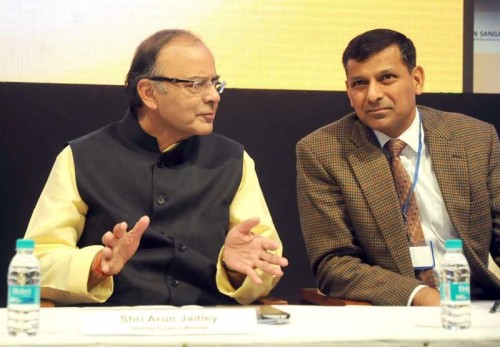
In a surprise development that sent stock markets soaring, India’s central bank cut its key lending rates by 25 basis points, expecting inflation to soften in the coming fiscal even as it expressed concern over the postponement of fiscal consolidation by a year.
Getting some positive cues from the national budget tabled last week, and sensing an economic recovery, the repurchase (repo) rate has been cut to 7.5 percent from 7.75 percent, while the reverse repo rate has been adjusted to 6.5 percent from 6.75 percent.
The rate cuts immediately follow a far-reaching agreement between the government and the Reserve Bank on Monday, under which the central bank will aim to bring the country’s retail inflation below the 6-percent mark by January 2016 and to around 4 percent by the end of 2016-17.
The announcement, which came just ahead of the opening bell for stock markets, brought much cheer to sentiments, prompting the sensitive index (Sensex) of the Bombay Stock Exchange to open nearly 345 points higher, over the previous close at 29,593.73 points.
The key index soon breached the 30,000-point mark to touch a historic high of 30,024.74 points, and was ruling at around 29,890 points around 30-minute into trading, with a gain of 300 points or 1 percent.
The situation was similar at the National Stock Exchange, where the Nifty also hit an all-time high.
“To summarise, softer readings on inflation are expected to come in through the first half of 2015-16 before firming up to below 6 percent in the second half,” Reserve Bank of Governor Raghuram G. Rajan said in a statement.
“The fiscal consolidation programme, while delayed, may compensate in quality, especially if state governments are cooperative,” said the governor who has otherwise been taking a rather conservative approach in dealing with the monetary policy, especially the interest rates.
“Given low capacity utilisation and still-weak indicators of production and credit off-take, it is appropriate for the Reserve Bank to be pre-emptive in its policy action to utilise available space for monetary accommodation.”
The repurchase rate is the interest commercial banks pay for borrowing money from the central bank to meet short-term fund requirements. The reverse repurchase rate is the interest central bank pays when surplus short-term funds are parked with it by banks.
In its monetary policy statement of Jan 15, 2015 the Reserve Bank had reduced the repo rate by 25 basis points, and said: “Key to further easing are data that confirm continuing disinflationary pressures.”
But it maintained its interest rate stance in its sixth bi-monthly monetary policy statement of Feb 3 in the absence of new developments on inflation or on the fiscal outlook, awaiting signals on that count and from the national budget.
While the next bi-monthly policy statement will be issued April 7, 2015 the still weak state of some sectors and the global trends, prompted the central bank, in its own admission, to become more anticipatory to make changes immediate in its stand.
In his statement on Wednesday, Rajan also lauded the Central Statistics Office (CSO) for the changes it made in the national income accounting, on which is based the country’s gross domestic product estimation, to bring it up to international standards.
“Yet the picture it presents of a robust economy, with growth having picked up significantly over the last three years, is at odds with still-low direct measures of growth of production, credit, imports and capacity utilisation as well as anecdotal evidence on economic cycle,” he said.
“Nevertheless, the picture of a steadily recovering economy appears right,” he added.
“Going forward, the RBI will seek to bring the inflation rate to the mid-point of the band of 4 percent (plus or minus 2 percentage points) provided for in the agreement, that is to 4 percent by the end of a two-year period starting fiscal year 2016-17.”